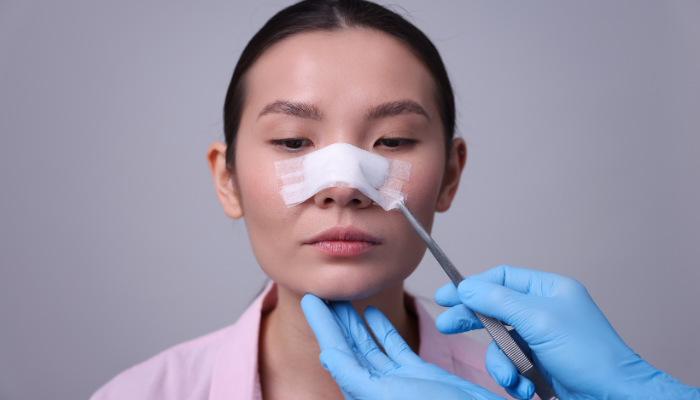If you’ve ever felt like your nose draws more attention than you’d like, you’re not alone. Reduction rhinoplasty offers a subtle but powerful way to bring balance to your facial features—without changing who you are.
Curious if this could be the right step for your aesthetic goals? Here’s what to know before you consider going under the knife.
Key Takeaways
- Reduction rhinoplasty is aimed at making the nose smaller or more proportionate to the face.
- Good candidates are those with realistic expectations and fully developed nasal structures.
- The consultation process is crucial for discussing goals and understanding the procedure.
- Recovery involves following post-operative care to ensure proper healing and results.
- Long-term results depend on various factors including individual healing and lifestyle.
Understanding Reduction Rhinoplasty

What Is Reduction Rhinoplasty?
Reduction rhinoplasty, at its core, is about nose reshaping to achieve better facial harmony. If you feel your nose is too large or prominent, making it the first thing people notice, then this procedure might be something to consider. It’s designed to reduce the overall size of your nose, refine its shape, and bring it into better proportion with your other facial features.
Reduction rhinoplasty can address a wide range of concerns, from reducing a dorsal hump (that bump on the bridge of your nose) to refining a bulbous tip or narrowing wide nostrils. It’s all about creating a nose that complements your face, rather than dominating it.
Benefits of Reduction Rhinoplasty
So, what’s in it for you? Well, the benefits extend beyond just aesthetics. Here’s a quick rundown:
- Improved Facial Harmony: A smaller, more refined nose can balance your features.
- Boosted Confidence: If you’ve been self-conscious about your nose, this can be a game-changer.
- Enhanced Breathing: In some cases, reduction rhinoplasty can also improve nasal airflow.
- Natural-Looking Results: Skilled surgeons aim for results that look like they were always meant to be.
Reduction rhinoplasty isn’t just about making your nose smaller; it’s about creating a nose that suits your face and helps you feel more confident in your own skin. It’s a personal journey, and the right surgeon will work with you to achieve your goals.
Common Reasons for Seeking Reduction Rhinoplasty
People consider reduction rhinoplasty for all sorts of reasons. It’s a very personal decision, but here are some common ones:
- Nasal Size: Feeling that the nose is disproportionately large compared to other facial features.
- Dorsal Hump: The presence of a bump on the nasal bridge.
- Bulbous Tip: A rounded or overly large nasal tip.
- Wide Nostrils: Nostrils that appear too wide or flared.
- Nasal Asymmetry: Noticeable differences between the two sides of the nose.
Identifying Suitable Candidates
Before you get too far ahead, it’s important to figure out if you’re actually a good candidate for the procedure. It’s not just about wanting a smaller nose; there are a few things to consider.
Physical Considerations for Candidates
First up, let’s talk about the physical side of things. It’s not a one-size-fits-all deal, and your nose needs to be, well, ready for it. Generally, surgeons prefer to work on noses that have finished growing. This usually means being at least 15 or 16, but it can vary.
Also, the structure of your nose matters. If you’ve got a really thick skin, for example, it might limit what can be achieved. Things like the size of your nostrils and the overall proportions of your face will also be taken into account.
Emotional Readiness for Surgery
Okay, so your nose is physically ready. But what about you? This is a big one, and it’s something people often overlook. You need to be doing this for yourself, not because someone else wants you to.
It’s also vital to have realistic expectations. Rhinoplasty can make a big difference, but it’s not magic. It’s not going to solve all your problems or make you look like someone else. It’s about enhancing what you already have. If you’re feeling anxious or unsure, it’s worth talking to a therapist or counsellor before going ahead.
Health Factors to Consider
Like any surgery, reduction rhinoplasty comes with risks, and your overall health plays a big part in how smoothly things go. If you’ve got any underlying health conditions, like diabetes or a bleeding disorder, it’s important to discuss these with your surgeon.
They might need to do some extra tests or take extra precautions. Smoking can also affect healing, so it’s usually recommended to quit before surgery. Basically, the healthier you are, the better your chances of a good outcome.
The Consultation Process
The consultation is a massive step. It’s where you and your surgeon get on the same page. It’s more than just a chat; it’s about building trust and understanding what’s achievable.
What to Expect During Your Consultation
Expect a thorough discussion about your medical history. Be honest about everything – medications, allergies, previous surgeries. Then, your surgeon will examine your nose, inside and out.
They’ll assess the structure, skin thickness, and how it all fits with your face.
Imaging is often involved, sometimes including computer simulations to give you an idea of potential results. This helps visualise the changes and ensures everyone’s clear on the goals. You’ll also talk in detail about what you hope to achieve with the surgery.
Don’t hold back – this is your chance to explain exactly what bothers you about your nose and what you’d like it to look like.

Importance of Setting Realistic Goals
This is a big one. Rhinoplasty can make a real difference. It’s important to have realistic expectations about what can be achieved. Your surgeon will help you understand what’s possible based on your individual anatomy and skin type.
Remember, the goal is to create a nose that looks natural and balanced with your other facial features. It’s about improvement, not perfection. Going in with realistic goals will help you be much happier with the final outcome.
The Surgical Procedure Explained
Overview of the Surgical Steps
Let’s break down what actually happens during the surgery. It’s not as scary as it sounds, honestly. The procedure usually starts with either an ‘open’ or ‘closed’ approach.
- With the open approach, a small cut is made across the columella (the bit between your nostrils). This allows the surgeon to lift the skin and have a really good view of the underlying bone and cartilage.
- The closed approach, on the other hand, involves all incisions being made inside the nostrils.
Once the surgeon has access, they’ll reshape the bone and cartilage to achieve the desired reduction. This might involve removing small pieces, or reshaping what’s already there. The key is precision, aiming for a natural-looking result that suits your face. Finally, the skin is re-draped, and the incisions are closed.
Anaesthesia and Recovery
Rhinoplasty is almost always performed under general anaesthetic, meaning you’ll be completely asleep during the procedure. This ensures you won’t feel a thing and that you’re relaxed throughout. The surgery itself can take anywhere from one to three hours, depending on the complexity of the case.
After the surgery, you’ll wake up in the recovery room. You’ll likely have a splint and some packing inside your nose to support it as it heals. It’s normal to feel a bit groggy and uncomfortable at first, but pain medication will help manage any discomfort.
Most people stay in the hospital for one night, just to be monitored, but some can go home the same day.
Post-Operative Care and Instructions
Okay, so you’re home and starting your recovery. This is where you play a big part in ensuring a good outcome. Here’s what you can expect:
- Swelling and Bruising: Expect some swelling and bruising around your eyes and nose. This is totally normal and will gradually subside over the first couple of weeks. Applying cold compresses can help reduce this.
- Pain Management: Stick to the pain medication prescribed by your surgeon. Don’t try to tough it out – keeping comfortable will help you rest and heal.
- Nasal Congestion: Your nose will feel blocked up, thanks to the swelling and packing. Try saline nasal sprays to keep things moist and prevent crusting.
- Activity Restrictions: Avoid strenuous activities, heavy lifting, and anything that could bump your nose for at least six weeks. This is super important to protect the healing tissues.
- Sleeping Position: Sleep with your head elevated on a couple of pillows. This helps to reduce swelling.
Remember, everyone heals at their own pace. Be patient with yourself, and don’t compare your recovery to others. If you have any concerns or notice anything unusual, don’t hesitate to contact your surgeon. They’re there to support you every step of the way.
Potential Risks and Complications
Alright, let’s talk about the less glamorous side of reduction rhinoplasty: the potential risks and complications. It’s super important to be aware of these before you make any decisions. No surgery is completely risk-free, but knowing what could happen helps you prepare and make informed choices.
Common Complications to Be Aware Of
So, what are some of the things that might go wrong? Well, here’s a rundown:
- Breathing Difficulties: Sometimes, the surgery can affect your nasal passages, leading to ongoing issues with breathing. It’s not super common, but it’s something to be aware of.
- Nosebleeds: Expect some nosebleeds during the initial recovery, but heavy or persistent nosebleeds are something to watch out for.
- Infection: As with any surgery, there’s a risk of infection. Your surgeon will give you antibiotics to help prevent this.
- Altered Sense of Smell: In rare cases, rhinoplasty can affect your sense of smell. This is usually temporary, but it can be permanent.
- Cartilage Damage: There’s a small risk of damage to the cartilage between your nostrils.
How to Minimise Risks
Okay, so how do you make sure you’re doing everything you can to avoid these complications? Here are a few tips:
- Choose a Qualified Surgeon: This is probably the most important thing you can do. Make sure to choose a board-certified surgeon and has plenty of experience with reduction rhinoplasty.
- Follow Instructions Carefully: Your surgeon will give you a bunch of instructions before and after the surgery. Follow them to the letter!
- Be Honest About Your Health: Tell your surgeon about any medical conditions you have, as well as any medications or supplements you’re taking.
- Don’t Smoke: Smoking can seriously interfere with healing, so quit before your surgery.
It’s also worth remembering that everyone heals differently. What works for one person might not work for another. Be patient with yourself and your body.
When to Contact Your Surgeon
It’s important to know when to reach out to your surgeon after your rhinoplasty. Here are some situations where you should definitely give them a call:
- Severe Pain: If you’re experiencing pain that’s not controlled by your pain medication.
- Signs of Infection: Redness, swelling, pus, or fever.
- Heavy Bleeding: Bleeding that won’t stop, even after applying pressure.
- Sudden Changes: Any sudden changes in your nose’s appearance or function.
- Concerns: If you’re just generally worried about something, it’s always best to get it checked out. It’s better to be safe than sorry!
Recovery and Aftercare

Now comes the recovery phase, which is just as important as the surgery itself. It’s all about following instructions, being patient, and giving your body the time it needs to heal properly.
Let’s break down what you can expect and how to make the process as smooth as possible.
What to Expect During Recovery
Right after the surgery, expect some swelling and bruising. It’s pretty normal, and ice packs are your best friend here. You’ll likely have a splint or cast on your nose to support it while it heals.
Pain is usually manageable with prescribed medication, but everyone’s different. The first few days are the toughest, so plan to rest and take it easy. After about a week or two, the splint comes off, and you’ll start to see some of the results, although it’ll still be a while before the final outcome is visible.
Tips for a Smooth Recovery
Here’s a few things that can help:
- Follow your surgeon’s instructions to the letter. They know what’s best for your specific situation.
- Keep your head elevated, even when sleeping. This helps reduce swelling.
- Avoid strenuous activities, like heavy lifting or intense exercise, for several weeks.
- Be gentle when cleaning your nose. Your surgeon will give you specific instructions on how to do this.
- Stay hydrated and eat a healthy diet to promote healing.
- Avoid smoking, as it can really slow down the healing process.
It’s easy to get impatient during recovery, but remember that healing takes time. Try to focus on the positive aspects of your decision and visualise the final results. Distract yourself with books, movies, or gentle hobbies to keep your mind occupied.
Follow-Up Appointments and Their Importance
Those follow-up appointments with your surgeon? They’re not just a formality. They’re crucial for monitoring your progress and catching any potential problems early on.
Your surgeon will check the incision site, assess the swelling, and make sure everything is healing as it should. Don’t skip these appointments, and don’t hesitate to ask any questions you have. It’s all part of ensuring you get the best possible outcome from your rhinoplasty.
Long-Term Results and Expectations
It’s natural to wonder what the future holds after undergoing reduction rhinoplasty. Let’s explore what you can realistically expect in the long run.
How Long Do Results Last?
Reduction rhinoplasty is generally considered a permanent procedure. The changes made to the bone and cartilage are designed to last a lifetime. However, it’s important to understand that the nose, like all parts of the body, will continue to change subtly with age.
Gravity and the natural loss of skin elasticity can cause minor alterations over many years, but these are usually not significant enough to warrant further surgery.
Factors Influencing Longevity of Results
Several factors can play a role in how well your rhinoplasty results hold up over time:
- Surgical Technique: A well-executed procedure using appropriate techniques is more likely to provide lasting results.
- Ageing Process: As mentioned, natural ageing can affect the skin and soft tissues of the nose.
- Lifestyle: Significant weight fluctuations or trauma to the nose can potentially impact the results.
- Adherence to Post-Operative Care: Following your surgeon’s instructions during recovery is important for optimal healing and long-term stability.
Maintaining Your New Look
While the structural changes from rhinoplasty are permanent, there are steps you can take to help maintain your new look:
- Protect your nose from injury: Wear appropriate protective gear during sports or activities where there’s a risk of facial trauma.
- Maintain a stable weight: Significant weight changes can affect the skin and soft tissues.
- Follow a healthy lifestyle: A balanced diet and regular exercise can contribute to overall skin health and elasticity.
It’s important to have realistic expectations about the long-term outcome of your rhinoplasty. While the surgery can create significant and lasting improvements, it won’t stop the natural ageing process. Open communication with your surgeon throughout the process is key to achieving the best possible results and maintaining them for years to come.
Conclusion
Deciding on reduction rhinoplasty is a personal choice—and it goes beyond just appearance. If your nose makes you feel self-conscious or holds back your confidence, this procedure might be something to explore.
Start by booking a consultation with a qualified surgeon. Be open about your goals and listen closely to their feedback. Most importantly, pay attention to how you feel during the consultation. Are they listening? Do you feel comfortable and understood? The right surgeon should not only offer expertise but also make you feel at ease.
Take your time to reflect, do your research, and don’t rush the decision. When everything aligns, you’ll know if it’s the right path for you.
Frequently Asked Questions
What is reduction rhinoplasty?
Reduction rhinoplasty is a type of nose surgery that makes the nose smaller or narrower. It can also reshape the tip and nostrils to create a more balanced look.
Who is a good candidate for this surgery?
Good candidates are usually people who feel their nose is too big or not in proportion with their face. They should also be in good health and have realistic expectations about the results.
What should I expect during recovery?
After the surgery, you might have some swelling and bruising. Most people can return to normal activities within two weeks, but it can take longer to see the final results.
Are there risks involved with reduction rhinoplasty?
Like any surgery, there are risks such as infection, bleeding, or dissatisfaction with the results. It’s important to discuss these with your surgeon.
How long do the results last?
The results of reduction rhinoplasty are usually long-lasting, but factors like ageing and lifestyle can affect the appearance of your nose over time.
What should I do before the surgery?
Before surgery, you should have a consultation with your surgeon to discuss your goals, medical history, and any concerns. Following their pre-operative instructions is also important.





